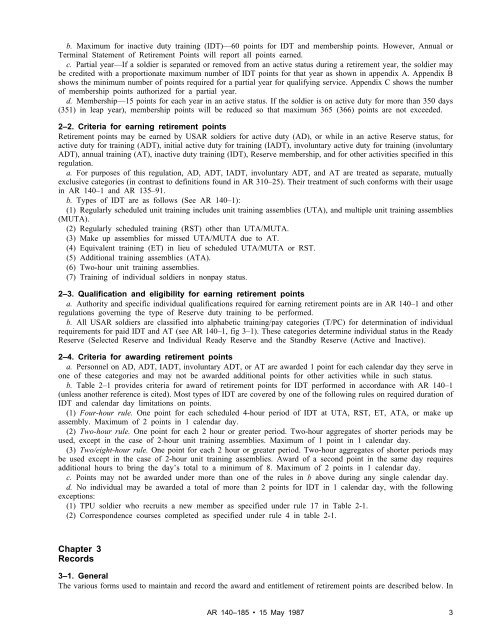Training and Retirement Point Credits and Unit Level ... - AskTOP
Training and Retirement Point Credits and Unit Level ... - AskTOP
Training and Retirement Point Credits and Unit Level ... - AskTOP
- No tags were found...
Create successful ePaper yourself
Turn your PDF publications into a flip-book with our unique Google optimized e-Paper software.
. Maximum for inactive duty training (IDT)—60 points for IDT <strong>and</strong> membership points. However, Annual orTerminal Statement of <strong>Retirement</strong> <strong>Point</strong>s will report all points earned.c. Partial year—If a soldier is separated or removed from an active status during a retirement year, the soldier maybe credited with a proportionate maximum number of IDT points for that year as shown in appendix A. Appendix Bshows the minimum number of points required for a partial year for qualifying service. Appendix C shows the numberof membership points authorized for a partial year.d. Membership—15 points for each year in an active status. If the soldier is on active duty for more than 350 days(351) in leap year), membership points will be reduced so that maximum 365 (366) points are not exceeded.2–2. Criteria for earning retirement points<strong>Retirement</strong> points may be earned by USAR soldiers for active duty (AD), or while in an active Reserve status, foractive duty for training (ADT), initial active duty for training (IADT), involuntary active duty for training (involuntaryADT), annual training (AT), inactive duty training (IDT), Reserve membership, <strong>and</strong> for other activities specified in thisregulation.a. For purposes of this regulation, AD, ADT, IADT, involuntary ADT, <strong>and</strong> AT are treated as separate, mutuallyexclusive categories (in contrast to definitions found in AR 310–25). Their treatment of such conforms with their usagein AR 140–1 <strong>and</strong> AR 135–91.b. Types of IDT are as follows (See AR 140–1):(1) Regularly scheduled unit training includes unit training assemblies (UTA), <strong>and</strong> multiple unit training assemblies(MUTA).(2) Regularly scheduled training (RST) other than UTA/MUTA.(3) Make up assemblies for missed UTA/MUTA due to AT.(4) Equivalent training (ET) in lieu of scheduled UTA/MUTA or RST.(5) Additional training assemblies (ATA).(6) Two-hour unit training assemblies.(7) <strong>Training</strong> of individual soldiers in nonpay status.2–3. Qualification <strong>and</strong> eligibility for earning retirement pointsa. Authority <strong>and</strong> specific individual qualifications required for earning retirement points are in AR 140–1 <strong>and</strong> otherregulations governing the type of Reserve duty training to be performed.b. All USAR soldiers are classified into alphabetic training/pay categories (T/PC) for determination of individualrequirements for paid IDT <strong>and</strong> AT (see AR 140–1, fig 3–1). These categories determine individual status in the ReadyReserve (Selected Reserve <strong>and</strong> Individual Ready Reserve <strong>and</strong> the St<strong>and</strong>by Reserve (Active <strong>and</strong> Inactive).2–4. Criteria for awarding retirement pointsa. Personnel on AD, ADT, IADT, involuntary ADT, or AT are awarded 1 point for each calendar day they serve inone of these categories <strong>and</strong> may not be awarded additional points for other activities while in such status.b. Table 2–1 provides criteria for award of retirement points for IDT performed in accordance with AR 140–1(unless another reference is cited). Most types of IDT are covered by one of the following rules on required duration ofIDT <strong>and</strong> calendar day limitations on points.(1) Four-hour rule. One point for each scheduled 4-hour period of IDT at UTA, RST, ET, ATA, or make upassembly. Maximum of 2 points in 1 calendar day.(2) Two-hour rule. One point for each 2 hour or greater period. Two-hour aggregates of shorter periods may beused, except in the case of 2-hour unit training assemblies. Maximum of 1 point in 1 calendar day.(3) Two/eight-hour rule. One point for each 2 hour or greater period. Two-hour aggregates of shorter periods maybe used except in the case of 2-hour unit training assemblies. Award of a second point in the same day requiresadditional hours to bring the day’s total to a minimum of 8. Maximum of 2 points in 1 calendar day.c. <strong>Point</strong>s may not be awarded under more than one of the rules in b above during any single calendar day.d. No individual may be awarded a total of more than 2 points for IDT in 1 calendar day, with the followingexceptions:(1) TPU soldier who recruits a new member as specified under rule 17 in Table 2-1.(2) Correspondence courses completed as specified under rule 4 in table 2-1.Chapter 3Records3–1. GeneralThe various forms used to maintain <strong>and</strong> record the award <strong>and</strong> entitlement of retirement points are described below. InAR 140–185 • 15 May 19873
















